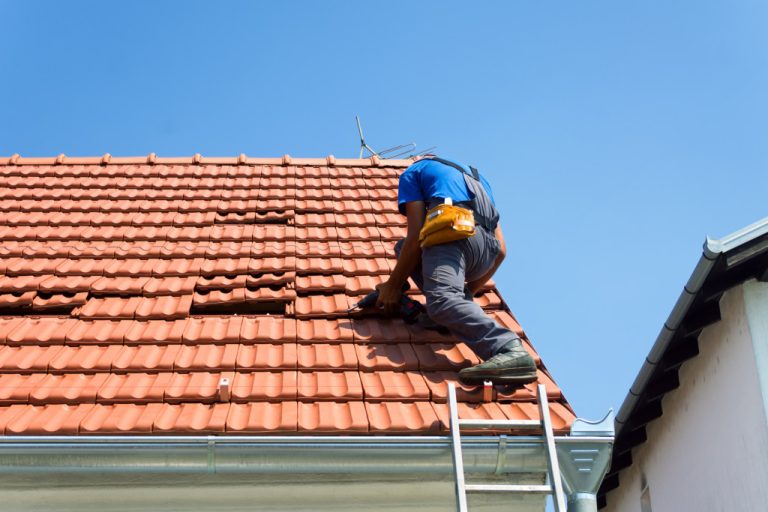• Inspect your roofing system for signs of damage and missing or broken shingles, and make necessary repairs.
• Install insulated roof panels to protect against extreme temperatures.
• Secure windows and doors with storm shutters and check the weather stripping for peeling or cracking.
• Install flood protection devices such as sandbags, barriers, sump pumps, and non-permeable membrane systems.
As the weather shifts and changes, it’s important to ensure that your home is prepared for whatever comes. In some areas, you may be more prone to extreme weather, such as hurricanes and heavy snowfall. Knowing how to prepare your home for extreme weather conditions will help ensure that your home is safe and secure during tougher climates. Explore some of the ways you can do this.
Check Your Roofing System
Your roofing system is especially vulnerable to extreme weather, so it’s important to inspect it regularly. The roof is the first to take the brunt of extreme weather conditions, so it should be checked for damage or signs of wear and tear. You should also ensure a reliable roofing system that can withstand high winds and heavy rain or snow. Here’s how you can check your roofing system:
Inspect the Shingles and Tiles
The shingles and the tiles on your roof can easily be damaged by hail, wind, or heavy rains. This is because they’re made of materials that can easily be affected by harsh weather. Inspect your roof for any signs of damage and ensure the tiles are properly attached. Check for any missing or broken shingles and make necessary repairs to keep your roof in tip-top shape.
Check the Gutters
Your gutters are essential for diverting excess rainwater from your home and preventing flooding. Make sure they are clear of any debris so the water can flow freely. If your gutters are clogged, the rainwater won’t be able to drain effectively and, instead, will puddle around your house. This can damage the foundation of your home and cause other issues. Consider adding gutter guards, which will keep debris from clogging up your drainage system and causing backups in the future.
Install Insulated Roof Panels
Installing insulated roof panels is a great way to protect your home from extreme temperatures. These panels provide an extra layer of protection for your roof, keep the heat out in hot climates, and retain the warmth inside during cold temperatures. This can make a huge difference in energy efficiency and keeping your home comfortable no matter the weather.

Secure Windows & Doors
Windows and doors are other areas where you must be extra vigilant during extreme weather. These are entry points for the elements and can easily be damaged by strong winds, hail, or heavy rains. You can start securing your house windows and doors by doing the following:
Install Storm Shutters
Storm shutters provide extra protection for your windows and doors during extreme weather conditions such as hurricanes and tornadoes. Installing storm shutters will help prevent wind and debris from entering your home. They are made from various materials, including aluminum, wood, and acrylic. Consider installing storm shutters to strengthen the area around your windows and doors.
Check the Weather Stripping
Weather stripping around your doors and windows helps seal the gaps between them and your home’s frame. This prevents outside air from entering and keeps moisture out during wet weather. Ensure all weather strippings are intact, and replace any worn down or damaged. Signs that it should be replaced are peeling or cracking of the material and if it has become loose.
Install Flood Protection Devices
If you live in an area prone to flooding, consider installing flood protection devices around your home. These can be anything from sandbags and barriers to sump pumps and non-permeable membrane systems.

- Sandbags are inexpensive to contain and divert water from your home. These are made of materials like burlap and will absorb the water. You can place these around your doors, windows, or any other entry points to keep the floodwaters out.
- Barriers are another great way to protect your home from flooding. These are typically made of plastic and come in various shapes and sizes. They can be placed around your property’s perimeter to create a barrier against the water.
- Sump pumps are great devices to help prevent flooding in your basement or crawl space. They collect and pump out excess water from these areas, keeping them dry during wet weather.
- Non-permeable membrane systems are an effective way of preventing seepage and leakage in your home. These are made of materials like plastic and rubber and can be installed around your foundation to keep water from entering.
These are just some ways to prepare your home for extreme weather conditions. Always take necessary precautions to protect your home and keep it safe in any climate. Doing so will help ensure that your house is strong, secure, and ready for anything Mother Nature throws.






